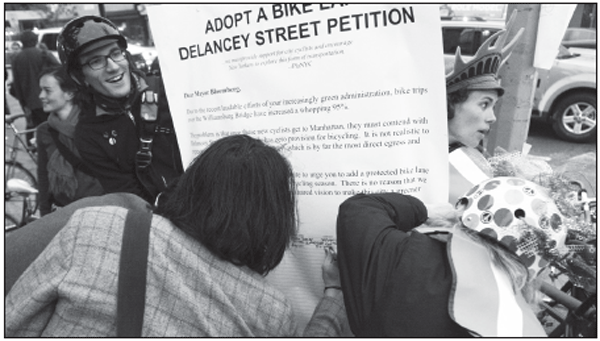By Jefferson Siegel
Every day, thousands of bicyclists commute to and from Manhattan via the Williamsburg Bridge. Getting to the bridge, though, is a hazardous journey. The feeder route to the bridge, Delancey St., is a busy, traffic-filled thoroughfare that makes cyclists run a daily obstacle course just to get to work or home.
Transportation Alternatives, the Chelsea-based advocacy group for bicycling, walking and public transit, has devised a creative way to raise the issue of safe cycling on this Lower East Side street. Last Friday, dozens of cyclists gathered on the corner of Delancey St. and Bowery to sign an oversized “Adopt A Bike Lane” petition.
“The idea is building community support,” said Caroline Samponaro, Transportation Alternative’s director of bicycling advocacy, as she held up the oversized document for cyclists to sign. “Here’s a route people want to ride on that we know is dangerous.”
The petition, addressed to Mayor Mike Bloomberg, notes that bike commuting on the bridge has increased 95 percent since the mayor’s green initiatives have taken root. However, there is still no bike lane on Delancey St. for the thousands of cyclists who share the busy, cross-town artery with cohorts of combustion-engine trucks and cars.
The petition urges Bloomberg to create a protected bike lane in time for next spring, when cycling traffic will increase with the temperatures.
Chris Hunt commutes to his Midtown job from Bedford-Stuyvesant.
“The bridge itself is great, the bike lane [on the bridge] is fantastic,” Hunt enthused. “But the entrance and exit on Manhattan is awful. It dumps you right onto Delancey. Every so often, you get an aggressive driver. Merging with the traffic is always problematic.”
T.A. has postcards addressed to the mayor that individuals can fill out and send to request a Delancey St. bike lane.
“Delancey St. is so critical to biking in this city,” observed Wiley Norvell, T.A. communications director. “We can do better than that.”
Norvell then joined a group of cyclists wearing bright orange vests in reading “Share the Road.” They pedaled east on Delancey St., across the bridge on its protected bike path and on to a party in Williamsburg.
Bike lanes generally fall into three categories: physically buffered, painted stripes on the street and posted signs. Bike lanes have blossomed throughout the city the past few years. A physically buffered lane along Ninth Ave. in Chelsea has won raves from the cycling community. Lanes painted green to alert drivers to their presence also have been rolled out on streets like Prince and Norfolk.
Another well-traveled cycle route — the nation’s most heavily used, in fact — is the Hudson River bikeway, running mostly physically protected and mostly uninterrupted from Lower Manhattan to the Upper West Side.


































